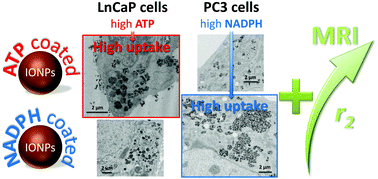ATP and NADPH coated iron oxide nanoparticles for targeting of highly metabolic tumor cells†
Abstract
The metabolic activity of tumor cells is known to be higher as compared to that of normal cells, which has been previously exploited to deliver nanomedicines to highly metabolic tumor cells. Unfortunately, current strategies, which are mostly based on complex energy sources, such as sugars, showed insufficient accumulation at the target sites. We here report the coating of IONPs with two essential units of cellular metabolism: adenosine triphosphate (ATP) and nicotinamide adenine dinucleotide phosphate (NADPH). ATP and NADPH were directly bound to the IONPs’ surface using a simple aqueous method. Both molecules were used as coatings, i.e. as stabilizing agents, but also simultaneously as targeting molecules to deliver IONPs to highly metabolic tumor cells. Indeed, we found that the uptake of ATP-IONPs and NADPH-IONPs is correlated with the metabolic activity of tumor cells, especially regarding their cellular ATP levels and NADPH consumption. We also measured one of the highest MRI r2 relaxivities for both ATP-IONPs and NADPH-IONPs. With the direct coating of IONPs with ATP and NADPH, we therefore provide an optimal platform to stabilize IONPs and at the same time promising properties for the targeting and detection of highly metabolic tumor cells.



 Please wait while we load your content...
Please wait while we load your content...